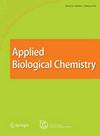Prediction of the Shelf-life of Chilled Foods at Various Temperatures
Journal of the Korean Society for Applied Biological Chemistry
Pub Date : 2008-01-01
DOI:10.3839/JKSABC.2008.063
引用次数: 2
Abstract
This study was designed to estimate the shelf-life of the popular chilled foods kimbab (rice rolled in dried laver), samgak kimbab (triangular rice rolled in dried laver), eomook (fish surimi, boiled fish paste) mook (acorn-starch jelly), and tofu (soybean curd) in large discount markets and convenience stores. Different types of chilled foods were stored at 5, 7, and 10 for 7 and 28 days, and changes in the total numbers of the aerobic bacteria were monitored. Values of 6 and 7 log cfu/g were used as the standard. Ready-to-eat foods stored at 5 showed a much longer shelf-life compared to storage at 10. The respective percentage increases in the shelf-life observed at both 7 and 5 were kimbab (70%, 171%), samgak kimbab (87%, 143%), soybean curd (46%, 95%), fish surimi (46%, 99%), and mook (45%, 87%). To reduce the microbiological contamination, storages at 7 and 5 are recommended for the increases of 45-88 and 87-171% in the shelf-life of these chilled foods.不同温度下冷藏食品保质期的预测
本研究旨在评估大型折扣市场和便利店中流行的冷冻食品金包饭(用紫菜干卷的米饭)、三乐金包饭(用紫菜干卷的三角形米饭)、鱼糜(鱼糜、水煮鱼酱)和豆腐(豆腐)的保质期。将不同类型的冷藏食品在5、7、10条件下分别保存7、28天,监测好氧菌总数的变化情况。以6、7 log cfu/g为标准。储存5年的即食食品比储存10年的食品保质期长得多。7号和5号的保质期分别增加了70%,171%,samgak kimbab(87%, 143%),豆腐(46%,95%),鱼糜(46%,99%)和鱼肉(45%,87%)。为减少微生物污染,建议将冷藏食品的保存期分别延长45- 88%和87-171%。
本文章由计算机程序翻译,如有差异,请以英文原文为准。
求助全文
约1分钟内获得全文
求助全文
来源期刊

Journal of the Korean Society for Applied Biological Chemistry
FOOD SCIENCE & TECHNOLOGY-FOOD SCIENCE & TECHNOLOGY
自引率
0.00%
发文量
0
审稿时长
4-8 weeks
 求助内容:
求助内容: 应助结果提醒方式:
应助结果提醒方式:


